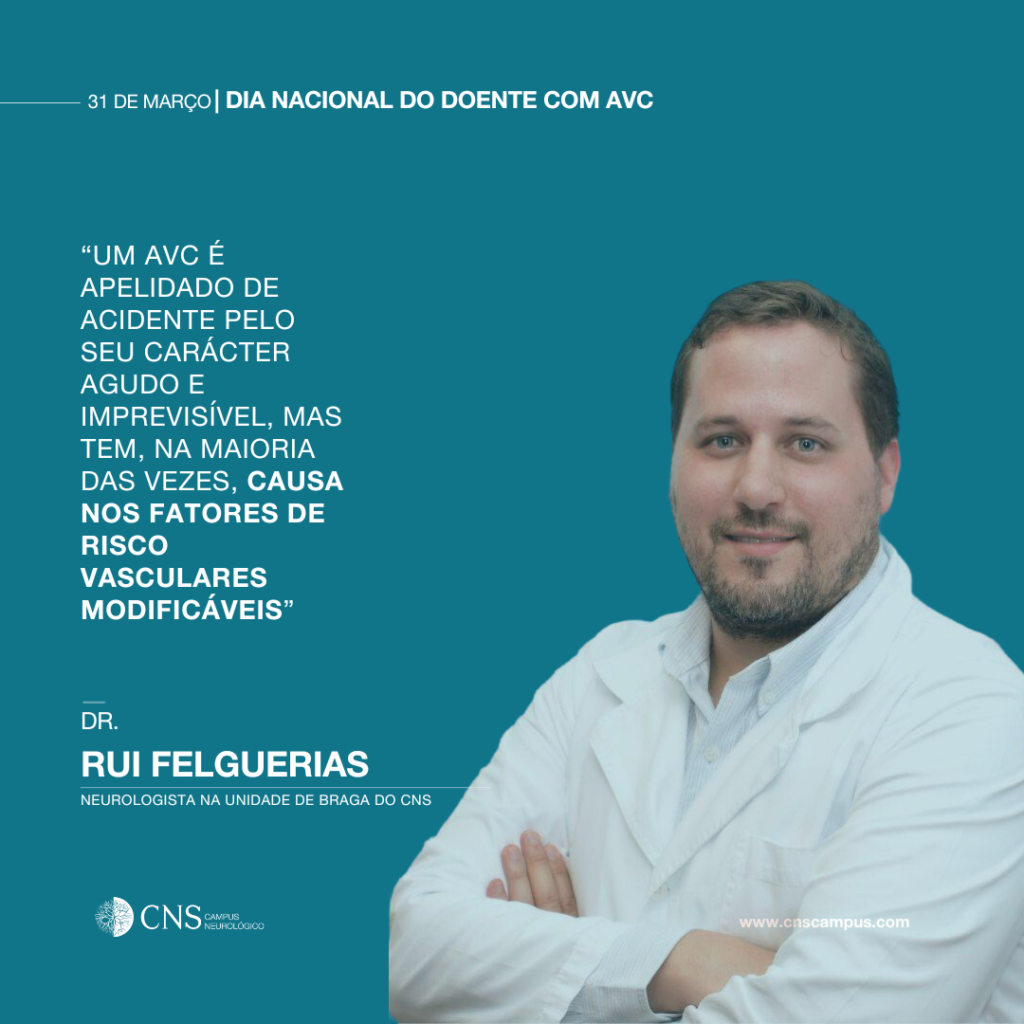March 31st marks the National Day of the Stroke Patient in Portugal. This event aims to raise awareness among the population about what remains the leading cause of mortality and disability in the country.
CNS joins this day by sharing an article from Dr. Rui Felgeiras, a neurologist at the Braga Unit of CNS – Campus Neurológico, on how to prevent and treat strokes.
A stroke, being largely preventable, is still one of the main causes of death and morbidity in Portugal. In common language, a stroke is referred to as an “accident” due to its acute and unpredictable nature. However, most often, strokes result from modifiable vascular risk factors. These modifiable risk factors include high blood pressure, smoking, diabetes, cardiac arrhythmias (especially atrial fibrillation), and high cholesterol levels. It’s known that 80% of strokes could be prevented with rigorous control of these risk factors. In this context, the importance of regular consultations with a family doctor cannot be overstated. Of course, there are other causes for strokes, especially in younger ages, but these are fortunately much rarer. Examples include autoimmune diseases, extracranial artery dissections, heart malformations, and even more rarely, genetic diseases.
The risk of stroke increases with age, and the absolute number of strokes will rise in the coming years due to the aging population, even with better risk factor control.
I would like to highlight the significant technical and scientific advancements made in recent years to treat patients who have suffered a stroke. I am referring to thrombolysis and thrombectomy, treatment tools where the earlier they are used, the greater the clinical benefit, hence the expression “time is brain”. Thrombolysis is an intravenous treatment that dissolves the clot responsible for cerebral ischemia and can be used within the first 4.5 hours. Thrombectomy is an endovascular or arterial catheterization treatment that can be used up to 24 hours after the stroke but is only available in some centers in the country to which patients are transferred when this treatment’s benefit is proven. I also want to emphasize the importance of post-acute care in stroke units, which are physical spaces and teams dedicated exclusively to treating acute stroke patients, with proven benefits for several years in these patients’ prognosis.
Given that time is crucial in acute stroke treatment, we come to the concept of the “Green Pathway” (Via Verde). This was created to ensure no time is lost in administering the appropriate treatment to each patient. It always starts with recognizing acute neurological deficits, either by the patient or by someone (family or otherwise) who assists or finds the patient in this state. In these circumstances, when faced with someone with an acute neurological deficit, such as facial asymmetry, speech alteration, or weakness on one side of the body, the first thing to do is call 112 (emergency number in Portugal). This way, everything can be prepared at the hospital so that no time is lost in the “Green Pathway”.
Lastly, stroke is a disease that not only causes weakness on one side of the body or speech difficulty. There are many other neurological deficits that are very relevant to the patient and their family. I’m talking about cognitive impairment and post-stroke depression, sometimes subtle but with serious consequences for the ability to return to work, usual activities, driving vehicles, having an active social life, having a healthy sexual activity… in short, having quality of life. And that’s the focus of those who care for stroke patients. Whether in the “Green Pathway” (preventing harm), in consultations (studying causes and consequences of stroke), or in rehabilitation (improving functionality), we all must aim for the best quality of life for each patient.
Dr. Rui Felgueiras,
Neurologist
Braga Unit of CNS – Campus Neurológico
